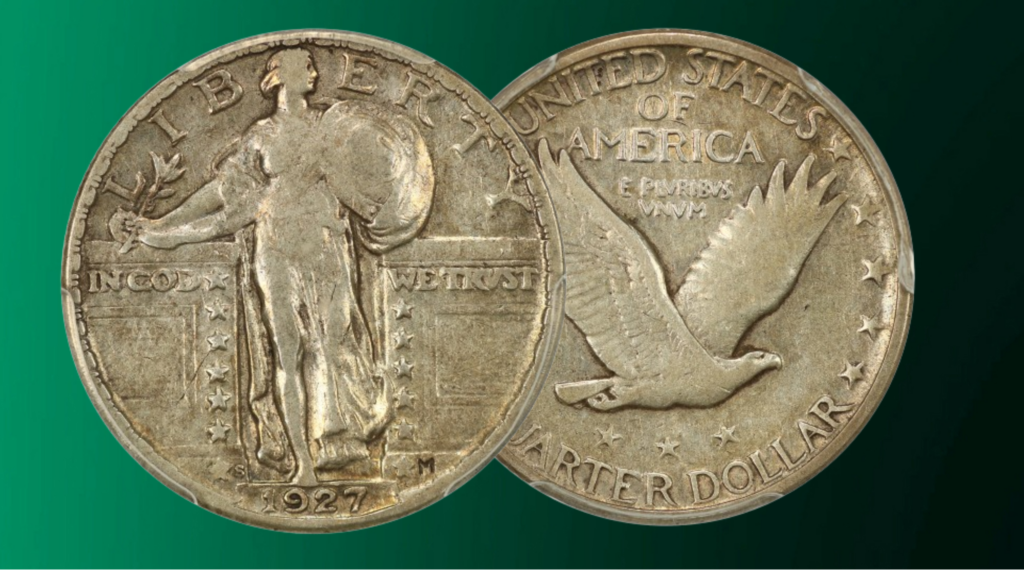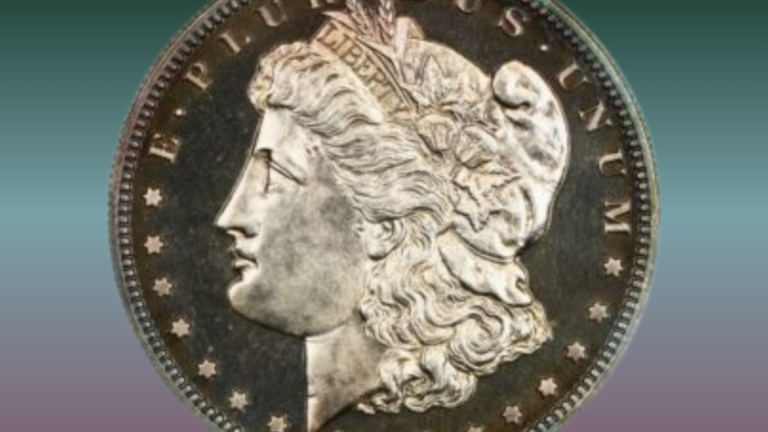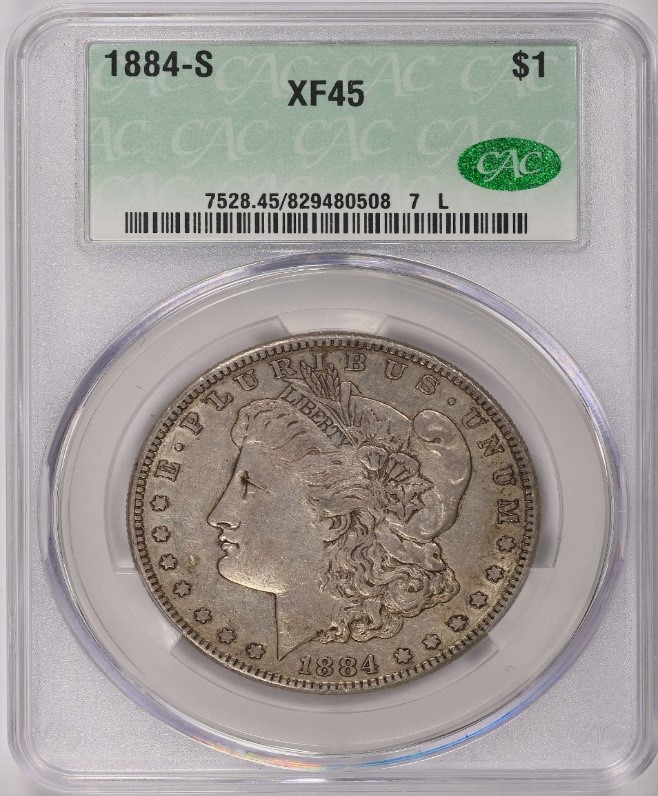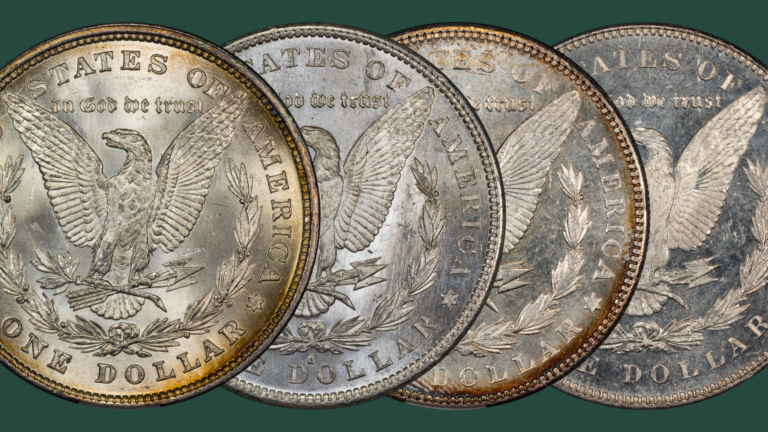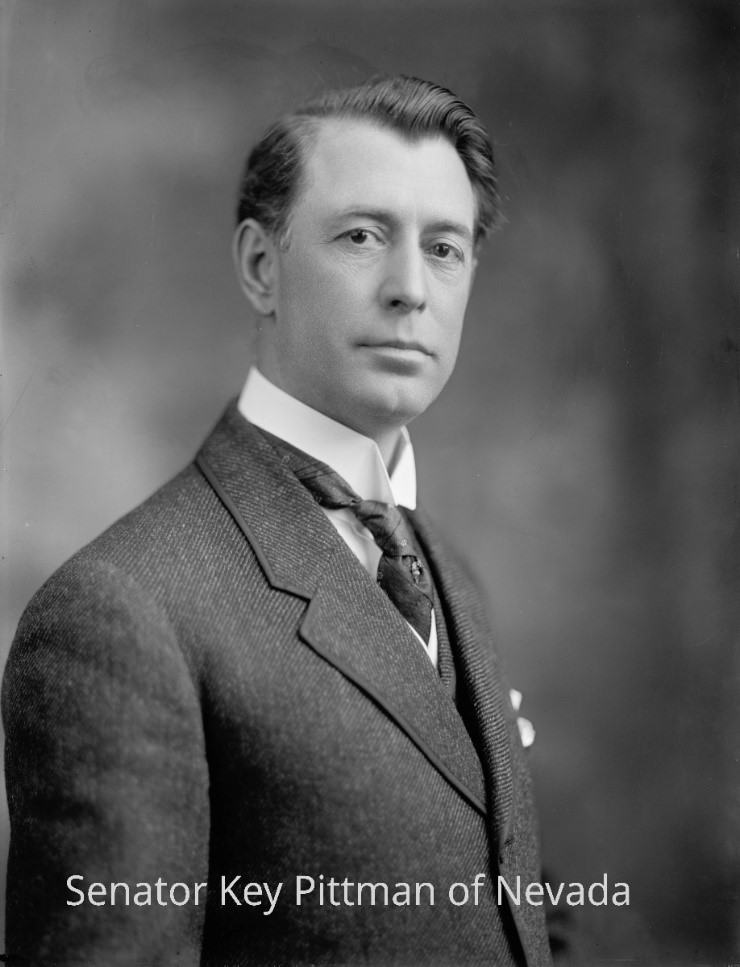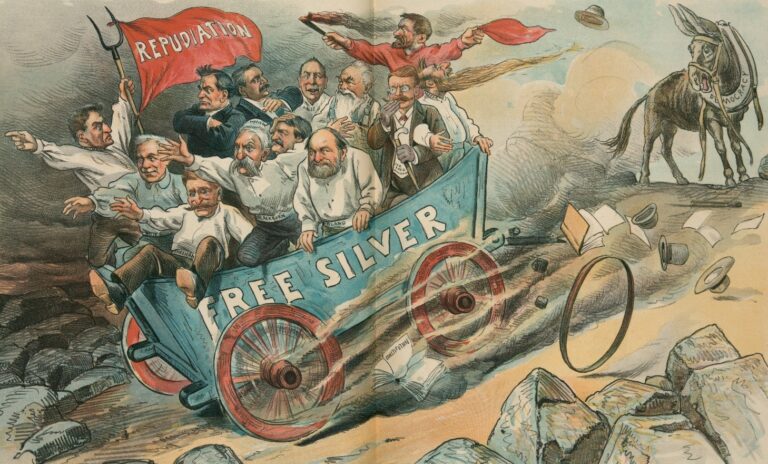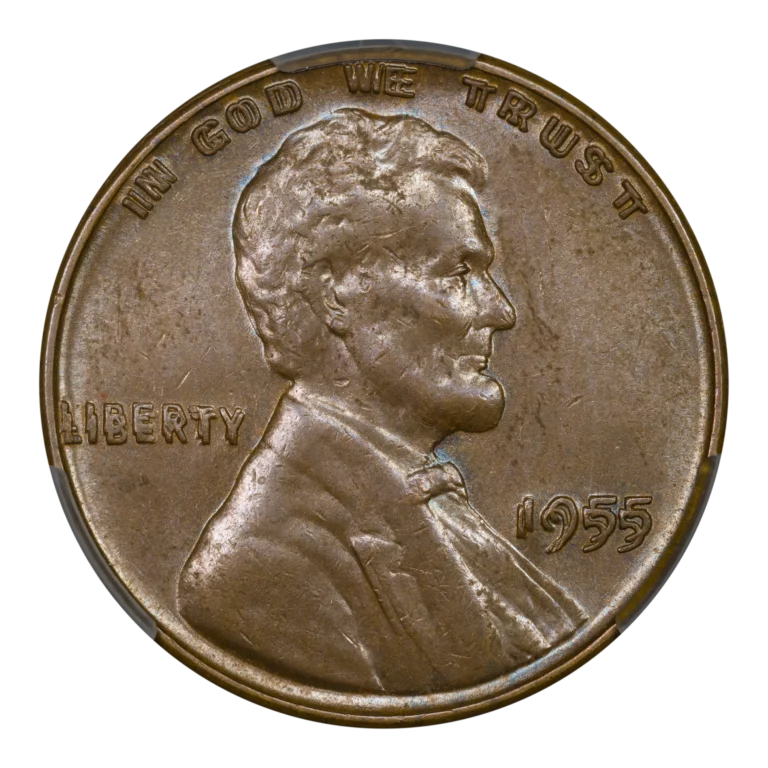by Greg Reynolds
Please see my article on ‘Circulated Standing Liberty Quarters, Type One’ for an introduction to Standing Liberty quarters (SLQs). Additional information and commentary about the design and historical circumstances are included in my article on the CAC website about building a set of Choice (MS-63) to Gem (65 and higher) grade SLQs. The present discussion is about circulated SLQs, those that grade below 60, of the second design type, which date from 1917 to 1930.
Costs & Availability
Not many circulated Type Two 1917, 1917-D and 1917-S SLQs were saved and were later submitted to CAC, partly because these are not considered as exciting as their Type One counterparts. Even so, CAC approved representatives of these dates become available at times and more may do so in the future as the total of circulated SLQs submitted to CACG in Virginia increases gradually.
NGC or PCGS graded coins with CAC stickers are said to be ‘CAC approved’ while coins in CAC holders are said to be CACG graded. As CAC grading (CACG) began in 2023, there are not yet a very large number of scarce, pre-1935 U.S. coins in CACG holders. Even so, many CAC stickered and CACG encapsulated SLQs are affordable in the context of classic U.S. coins. Many collectors find that it is enjoyable and relaxing to build a set, which is practical, without spending a fortune.
If a CAC approved or CACG graded VF-20 grade Type Two 1917 is offered in late 2024 or 2025, it would probably be priced below $110. A VF-25 or VF-30 grade 1917 would not cost much more than $110.
On June 5, 2022, GreatCollections sold a CAC approved VF-35 grade Type Two 1917 SLQ for $182.60. It is a realistic possibility that the toning on this coin spurred prospective buyers to bid more than they would otherwise have bid. It is likely that the concentric toning of multiple colors on this 1917 SLQ is at least partly attributable to a Wayte Raymond “National” album or board, or to another brand of widely used albums in the past. As I have not seen this coin, I am not drawing a conclusion, though it is certainly pretty in pictures on the GreatCollections website.


A CAC approved XF-45 or lower grade Type Two 1917-D or 1917-S should each retail for less than $200. They are not available very often. It would be easier to buy AU-58 grade representatives of these two than CAC approved XF-40 or VF-20 grade coins.
As of July 1, 2024, CAC has approved sixteen Type Two 1917-S SLQs as grading AU-58 plus six more with a ‘Full Head’ (FH) designation, for a total of twenty-two. The CPG-CAC retail price estimate for those fourteen without a FH designation is $310. The CPG-CAC retail price estimate for the sole CAC approved VF-25 grade Type Two 1917-S is $155, though this is just an estimate. Actual selling prices are affected by several variables. In regards to the sale of a scarce coin, each combination of a slice of time and a particular setting is different.
1918 to 1920 Standing Liberty Quarters
With or without a FH designation, it is tough to find a CAC approved, circulated 1918. On June 2, 2024, GreatCollections sold a CACG certified AU-55-FH 1918 for $225.50.
It is easier to find a CAC approved, circulated 1918-D than a 1918 SLQ. On Feb. 26, 2023, GreatCollections sold a CAC approved AU-58-FH 1918-D for $544.50. An AU-55 grade 1918-D without a FH designation would be likely to have a medium retail value below $250. To budget-minded collectors of SLQs, I suggest waiting for a much less costly 1918-D before paying more than $500 for a circulated 1918-D.
Back on June 24, 2018, a time during which coin markets were sluggish and were drifting downward, GreatCollections sold a CAC approved AU-58-FH 1918-S for $310.93. If this same coin had been sold again by GreatCollections during August 2024, it would probably have brought a much higher price. As with the 1918-D, though, I suggest seeking a circulated 1918-S without a FH designation, perhaps a coin that has more than two-thirds of a head.
For a set of circulated SLQs, FH designations are not particularly important, from a logical perspective. Even if ‘full’ to begin with, the heads wore down while SLQs were in circulation.
Even with a very flat head, a 1918/7-S would be likely to be very expensive. Indeed, the 1918/7-S overdate is a key and is the scarcest Type Two SLQ.
During the twentieth century, the numerals of the year (‘the date’) were typically included in each obverse (front) hub that was used to make working dies, which, in turn, were used to mint coins. Usually, a die was struck more than once with a hub and the die was heated in between strikings. After the 1918/7-S die was impressed with a 1917 obverse hub and then heated (annealed), it was then impressed, perhaps by mistake, with a 1918 obverse hub. Both a numeral ‘8’ and a numeral ‘7’ beneath the ‘8’ were apparent on this die and the overdate appeared on each coin that was struck with this die.
On March 31, 2024, GreatCollections sold a CAC approved VG-08 grade 1918/7-S for $3245. On May 4, 2022, Heritage sold a CAC approved VF-30 grade 1818/7-S for $4800.
The 1919 is a better date, though not a semi-key. On May 12, 2024, GreatCollections sold a CAC approved AU-55 grade 1919 SLQ for $220. If there was a CAC approved XF-40 grade 1919, it might very well have a medium retail value of around $100 during late 2024 or 2025.
The 1919-D and the 1919-S are semi-keys. As uncirculated (‘MS’) SLQs of these two dates are relatively expensive, a substantial number of circulated coins have been submitted to CAC.
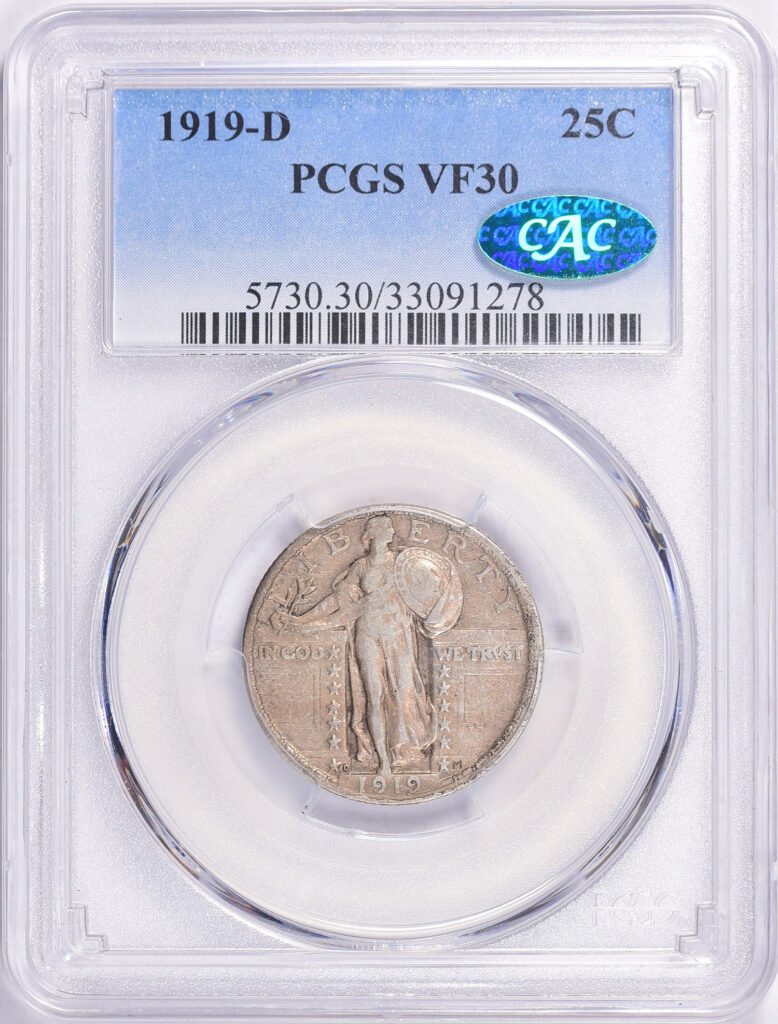
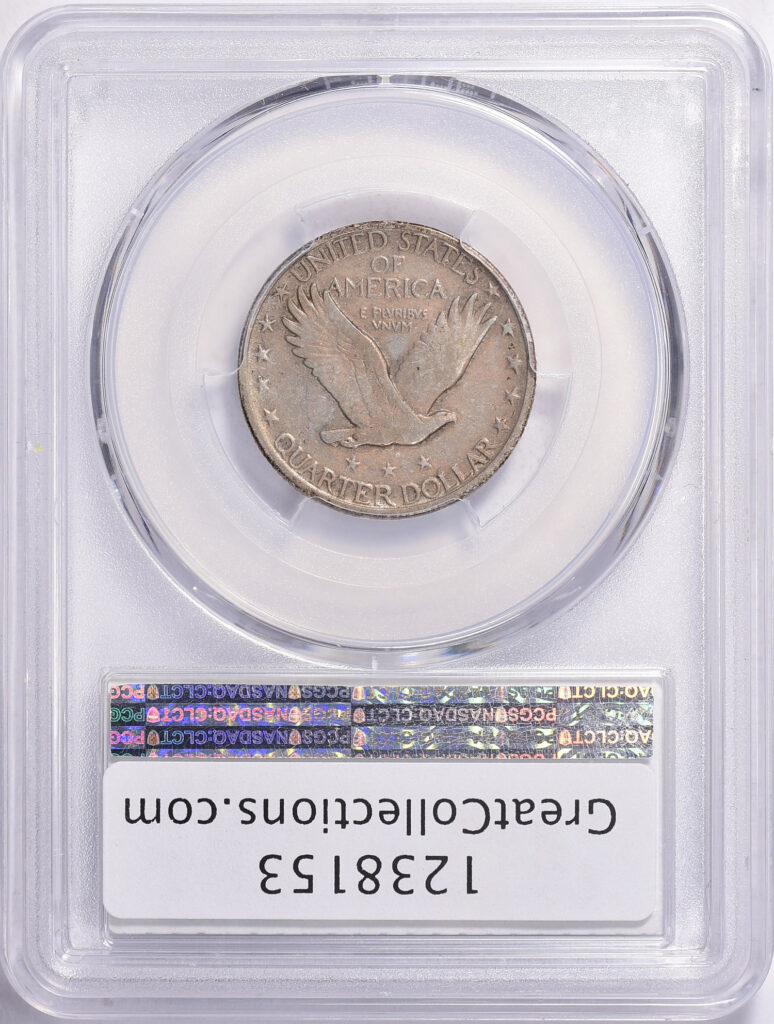
On Dec. 11, 2022, GreatCollections sold a CAC approved VF-30 grade 1919-D for $511.50. The current CPG-CAC medium retail estimate for a VF-30 grade 1919-D is $595. In contrast, the current CPG-CAC medium retail estimate for a MS-64 grade 1919-D is $5100, more than eight times as much.
On Feb. 22, 2022, GreatCollections sold a CAC approved, NGC graded VF-30 1919-S for $499.40. On Aug. 1, 2021, GreatCollections sold a CAC approved, PCGS graded XF-40 1919-S for $634.70.
Although a severe recession dampened the U.S. Economy while they were minted, 1920, 1920-D and 1920-S SLQs are not particularly scarce. This recession had an effect on mintages during the years that followed.
The 1920 is just a slightly ‘better date.’ A CAC approved AU-53 to -58 grade 1920 will probably become available frequently enough. If not, there are a substantial number of circulated 1920 quarters that would be CAC approved if they were submitted.
In circulated grades, the 1920-D is much scarcer than the 1920 or the 1920-S. As of August 12, 2024, CAC has stickered fifty-one 1920-D quarters and CACG has encapsulated seven, two of which were placed in ‘Details’ holders because they failed to receive numerical grades. On Feb. 15, 2022, Heritage sold a CAC approved VF-35 grade 1920-D for $276.
On Sept. 17, 2023, GreatCollections sold a CAC approved AU-58 grade 1920-S for $375.10. A CAC approved XF-40 grade 1920-S, if there was one, would be likely to retail for an amount in the range of $70 to $115. Although it might not be cost-effective, it would be fun to buy some raw, apparent Fine to Very Fine grade 1920-S quarters for $25 to $60 each and then submit them to CACG.

Show off Your Collection in the CAC Registry!
Have CAC coins of your own? If so, check out the CAC Registry–the free online platform to track your coin inventory, showcase your coins by building public sets, and compete with like-minded collectors!
Economic Recession of 1920-21
The severe recession of 1920-21 had an impact on both the mintages and the survival rates of SLQs. In regard to quarters produced just before this recession, the mintages in Philadelphia in 1918 (14.24 million), 1919 (11.32 million) and 1920, a staggering 27.86 million, were rather large. The official 1920 census indicated that there were 106,021,568 residents of the United States. Any quarter could easily have circulated for more than a decade.
In Denver, mintages of the 1918-D (7.38 million), the 1919-D (1.94 million), and the 1920-D (3.59 million), were substantial, considering that the Western United States was rather sparsely inhabited at the time, and Denver is less than 1000 miles from San Francisco. In 1920, only about 9.2 million people, less than 9% of the U.S. population lived in the West, including Denver and San Francisco. One hundred years later, in 2020, nearly 24% of the U.S. population lived in the West.
The mintage for the 1918-S SLQ was 11.07 million, and was 1.84 million for the 1919-S, yet 6.38 million for the 1920-S. Generally, large quantities of SLQs were minted from 1918 to 1920, in the context of the population at the time. Again, around nine million people lived in the West while the total mintage of 1918-D and 1918-S SLQs was more than eighteen million.
After the severe recession overwhelmed the nation in the middle of 1920, there was an oversupply of quarters in the West. At the Denver Mint, quarters were not struck in 1921, 1922 or 1923. At the San Francisco Mint, quarters were not struck in 1921 or 1922, and just 1.36 million 1923-S quarters were produced. In 1921, SLQs were minted only in Philadelphia.
Some uncirculated 1921 SLQs were kept as bank reserves or by people hoarding silver coins as U.S. citizens often did during severe recessions or other unsettling periods of time. Circulating 1921 quarters, however, tended to wear down until they were of very low grades. Many were melted. Technically sound, VF-20 to AU-50 grade 1921 quarters are now truly scarce.
On Nov. 28, 2021, GreatCollections sold a CAC approved, NGC graded XF-45 1921 SLQ for $803. In August 2024, The CPG-CAC medium retail estimate for a VF-20 grade 1921 SLQ was $655.
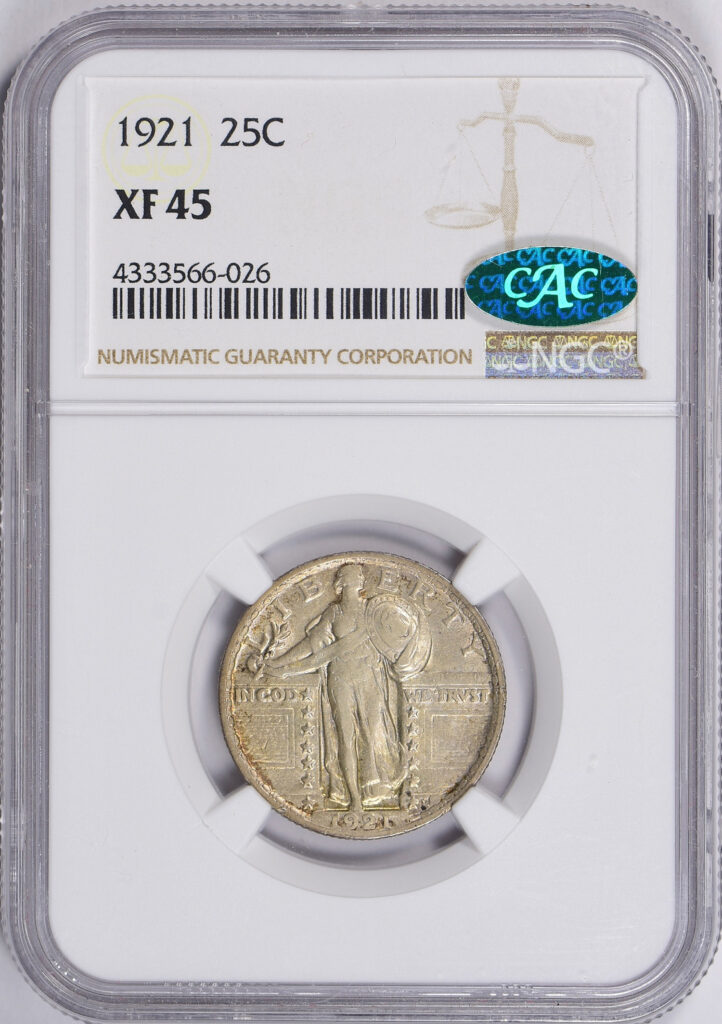
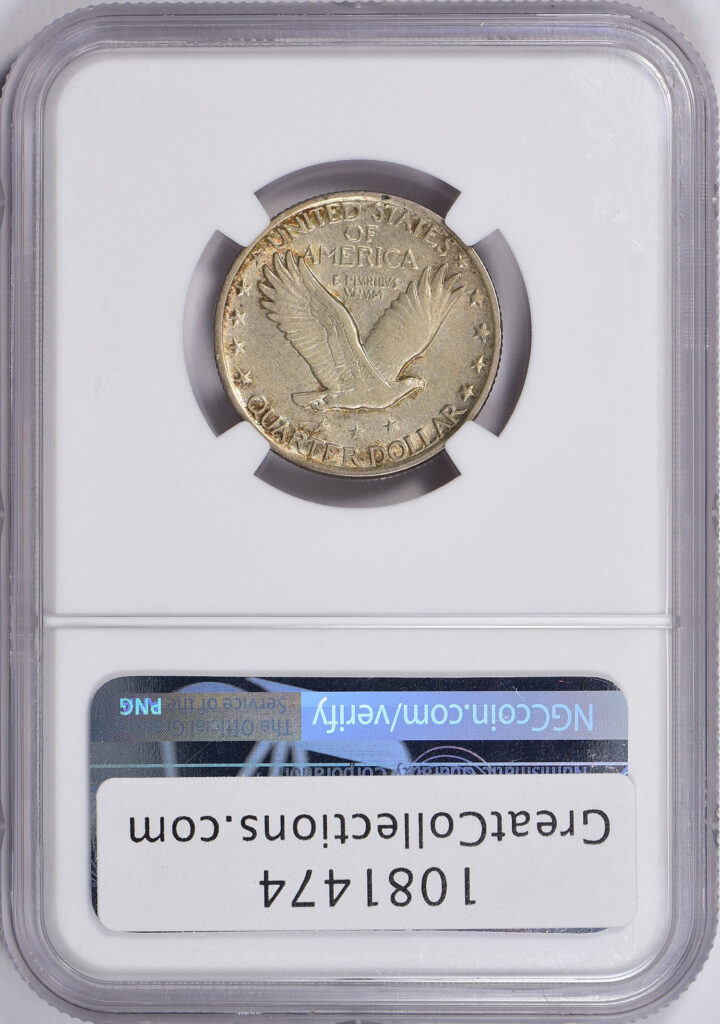
SLQs were not minted anywhere in 1922. The 1923-S is a semi-key. During 1923, there were enough SLQs around to satisfy demand, as mintages from 1918 to 1920 were large, and the 1920-21 recession had reduced demand for quarters. The mintage of the 1923-S (1.36 million) was less than one-fourth of the mintage of 1920-S quarters (6.38 million), the last year before 1923 that quarters were minted in the West. The mintage of 1923-D quarters, zero, was much less than the mintage of 1920-D quarters (3,586,400). In sum, all the SLQs produced in the West from 1921 to 1923 were the 1.36 million 1923-S quarters minted.
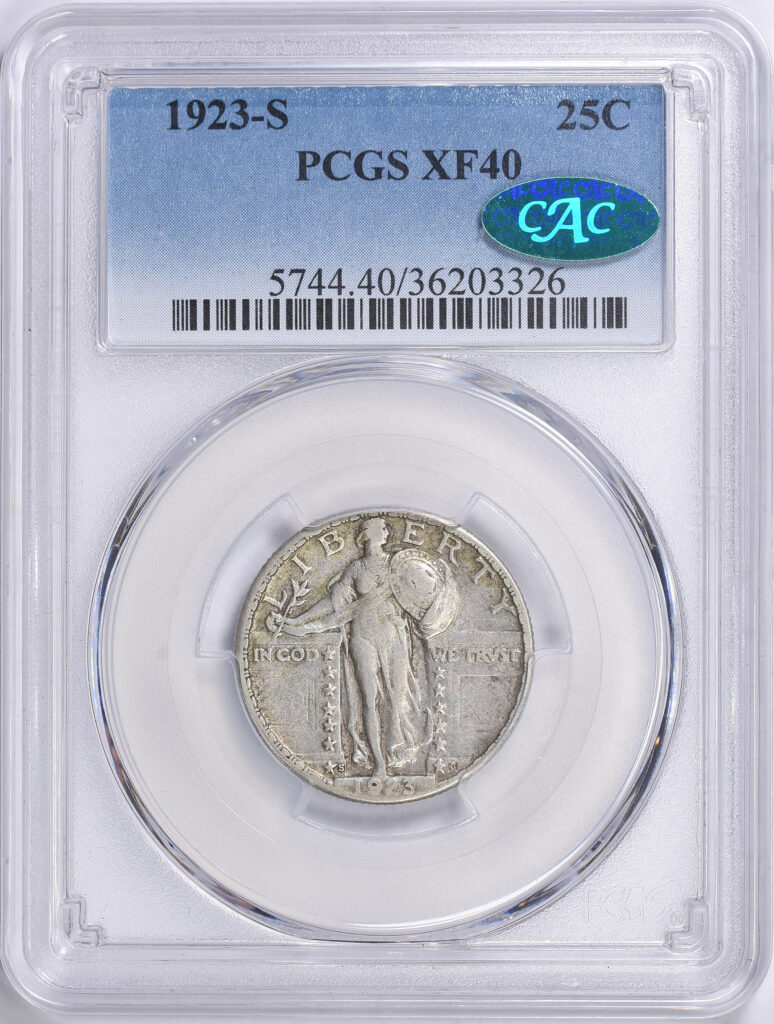
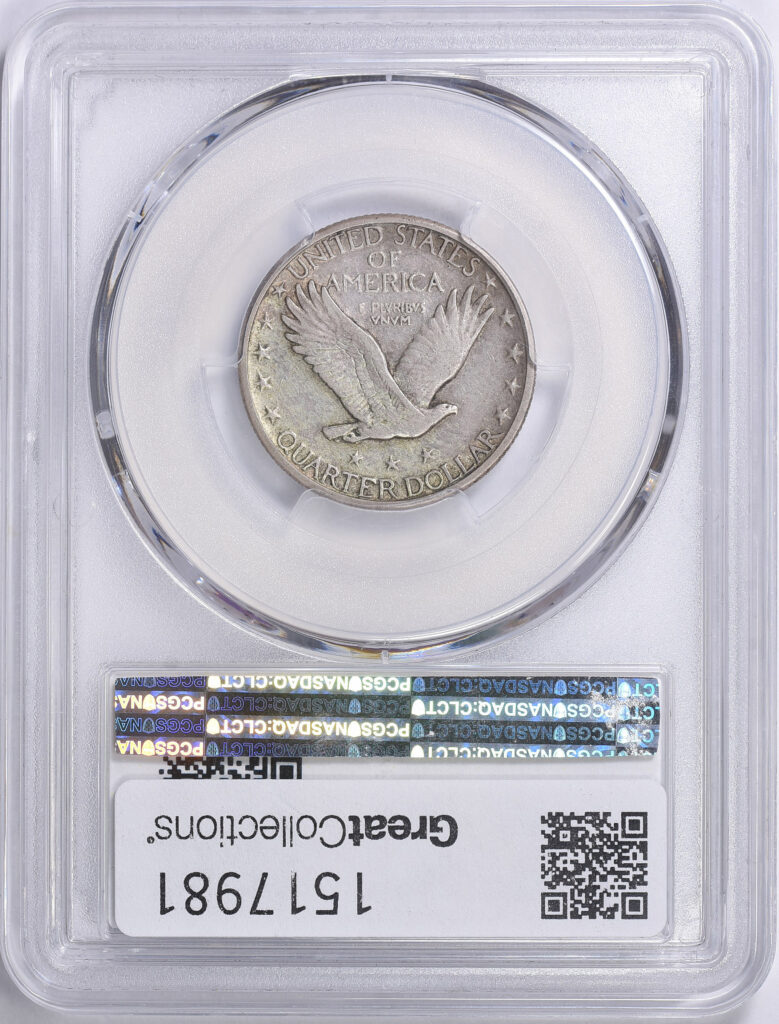
Even so, it is practical now to seek a CAC certified 1923-S, more than one hundred years later. Attractive, naturally toned, circulated 1923-S quarters survive.
On Jan. 28, 2024, GreatCollections sold a CAC approved XF-40 grade 1923-S for $1705. If there was a CAC approved VG-08 1923-S, it would have a medium retail value of around $500.
Generally, it is easier to find very appealing, circulated SLQs minted from 1924 to 1930 than those dated earlier. Regarding searches for pre-1924, circulated SLQs, Warren Mills provides some pointers.
Collecting Advice from Warren Mills
Mills is the vice president of Rare Coins of New Hampshire. I became acquainted with Warren after he was highly recommended to me by the legendary expert Charlie Browne, who was known for more than thirty-five years as one of the leading graders in the coin community. Unlike the peanuts character, Charlie spelled his last name with an ‘e’ at the end. Charlie was one of my mentors. Warren has been helpful, too.
“A collector shouldn’t get hung up on whether a better date Standing Liberty quarter grades VG-08, XF-45, or a grade in between, it makes more sense to focus on originality,” Mills declares. Warren recommends “attractive medium toned” SLQs.
Warren finds that “CAC has been more strict than PCGS or NGC in regard to washed out surfaces or altered legs. Always take original Fine to Very Fine grade coins over higher grade coins that are not so original,” Mills advises. Warren is very concerned about dealers “who mess with coins,” as was Charlie Browne.
Mills “would rather have an original Fine-12 quarter than an XF-45 grade coin that has been dipped or brightened in some other way.” Even though Warren weighs originality more heavily than other factors, Mills insists that collectors must “make some allowances. If a collector is too picky, he will buy hardly any coins, and will later regret not buying some of the coins that were offered to him.” Appealing pre-1924 SLQs “are not easy to find.” It is important to be realistic.
According to Warren, there are no longer any secrets or mysteries regarding the relative scarcity of the dates in the series. While the CPG-CAC price guides fairly indicate which dates are scarcer, the CPG-CAC retail price estimates for circulated SLQs are “too low,” Mills asserts.
Warren reveals that he has “a personal, circulated set of SLQs that grade from VG-08 to MS-62. I love every one of them,” he exclaims, “This is a cherished set in my collection. I have been working on this set for more than a quarter-century”!
Warren notes that acquiring attractive, medium toned, relatively original, pre-1924 dates often requires patience. In contrast, Mills emphasizes that there are “thousands” of later SLQs. They are “common” and most of these have never been certified. Many common SLQs, though, “have been cleaned,” he says. It is a challenge to find and obtain “really nice common date” circulated SLQs, Warren maintains.
1924 to 1926 Standing Liberty Quarters
Mills and I agree that really appealing, relatively original, circulated SLQs dating from 1924 to 1926 are scarcer than most interested collectors realize. The 1924 is a slightly better date overall. In grades below AU-50, a 1924 SLQ is generally priced below $120, though few of those are exceptionally appealing. On June 4, 2023, GreatCollections sold a CAC approved, PCGS graded VF-30 1924 for $84.70.
In grades from VF-20 to AU-53, the 1924-D is a ‘better date’ and the CPG-CAC retail estimates range from $165 to $295, as of Aug. 12, 2024. In grades below XF-45, the 1924-S is estimated to cost considerably less than the 1924-D. On Oct. 23, 2022, GreatCollections sold a CAC approved XF-40 grade 1924-S for $341. On that 1924-S, it is apparent that the numerals of the ‘date’ wore quickly. In 1925, the design was modified to slow down the rate of such wear.
In circulated grades, the 1925 and the 1926 are common dates. For both, the CPG-CAC medium retail estimate for a VF-20 grade coin is $19, though there are zero of each in VF-20 grade in the CAC population report. Grading costs would outweigh the retail value of each certified VF-20 grade 1925 or 1926 SLQ, though collectors sometimes submit such coins for educational purposes.
In XF-45 grade, there is a CAC population of one 1925 and one 1926; each is CPG estimated to have a medium retail value of $73. On June 16, 2024, GreatCollections sold a CAC approved AU-58 grade 1925 SLQ for $287.10.
In VF-20 to AU-58 grades, the 1926-D is a slightly better date and the 1926-S is notably scarcer than the 1926-D, though the price difference in VF grades is CPG estimated to be just $10 to $25 each for coins of equivalent quality and eye appeal. In AU grades, a 1926-S costs much more than a commensurable 1926-D.
On Sept. 5, 2021, GreatCollections sold a CAC approved AU-55 grade 1926-D for $138.63. On July 24, 2022, GreatCollections sold a CAC approved AU-55 grade 1926-S for $423.50. For GreatCollections auctions, it is correct, in my view, to add 10% to the hammer price to determine the price realized. By tradition, applicable (if any) credit card charges, electronic payment fees, sales taxes and shipping expenses are all regarded as later additions, not components of auction prices realized.

Late Date (1927-1930) Standing Liberty Quarters
In circulated grades, the 1927 is a very common date. The 1927-D is definitely a better date. It might be even more difficult to find a CAC approved, sub-60 grade 1927-D SLQ than the small number listed in the pop report suggests. Indeed, I do not recollect ever seeing a circulated 1927-D with a CAC sticker. Publicly available listings of CAC approved sub-60 grade 1927-D SLQs tend to be more than a half-dozen years old.
The 1927-S is the ‘queen of the late dates.’ In my discussion of Choice (MS-63) to Gem (65 and higher) grade SLQs, I point out that she is an extreme rarity with a ‘FH’ designation. Fortunately for budget-minded collectors assembling sets of circulated coins, CAC approved 1927-S quarters in sub-60 grades are not all that rare.
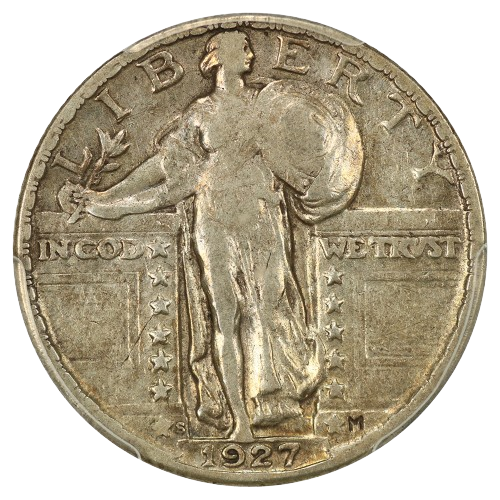
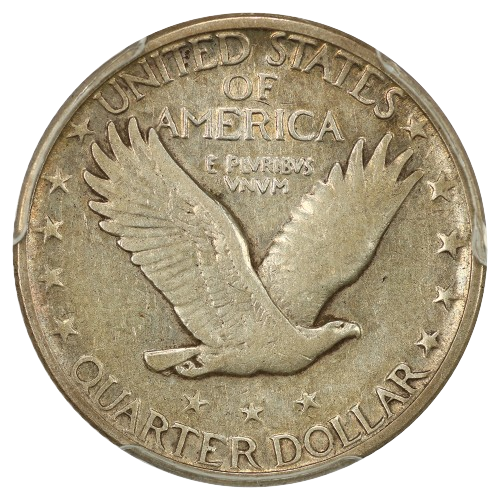
Back on April 6, 2021, Heritage sold a CAC approved Fine-15 grade 1927-S SLQ for $174. On April 2, 2023, DLRC sold a CAC approved VF-25 grade 1927-S for $325. On July 14, 2024, GreatCollections sold a CACG graded Good-06 1927-S for $68.20.
The 1928, 1928-D, 1928-S, 1929, 1929-D, 1930 and 1930-S are all regarded as common dates. For each, the CPG-CAC estimates for medium retail values are $19 for a VF-20 grade coin and $49 for an XF-40 grade coin. In 2024 or 2025, it may be difficult to find CAC approved SLQs of these dates in the VF to XF grade range. It is likely, though, that more than a few XF-40 to AU-55 grade coins of these dates will be submitted to the CACG office in Virginia in the not too distant future.
On Feb. 26, 2023, GreatCollections sold a CAC approved AU-58 grade 1928 for $144.38. On March 5, 2023, GreatCollections sold a CAC approved AU-58 grade 1930 SLQ for $170.50.
Concluding Remarks
In the context of circulated, classic U.S. coins (1790s to 1930s), CAC approved or CACG graded SLQs are not particularly expensive. The 1916 and the 1918/7-S are the only two dates that are very costly. A collector can complete most or all the rest of the set before deciding upon an approach to acquiring a 1916 and a 1918/7-S.
In circulated grades, the 1919-D, 1919-S, 1921 and 1923-S are semi-keys. Circulated SLQs of most dates, however, are not expensive. It is challenging, though, to find and obtain relatively original, medium toned, attractive SLQs of all dates. If it was too easy to complete an exceptionally appealing set, it would not be fun to do so.
Images are courtesy of Great Collections.
Copyright © 2024 Greg Reynolds
About the Author
Greg is a professional numismatist and researcher, having written more than 775 articles published in ten different publications relating to coins, patterns, and medals. He has won awards for analyses, interpretation of rarity, historical research, and critiques. In 2002 and again in 2023, Reynolds was the sole winner of the Numismatic Literary Guild (NLG) award for “Best All-Around Portfolio”.
Greg has carefully examined thousands of truly rare and conditionally rare classic U.S. coins, including a majority of the most famous rarities. He is also an expert in British coins. He is available for private consultations.
Email: Insightful10@gmail.com
